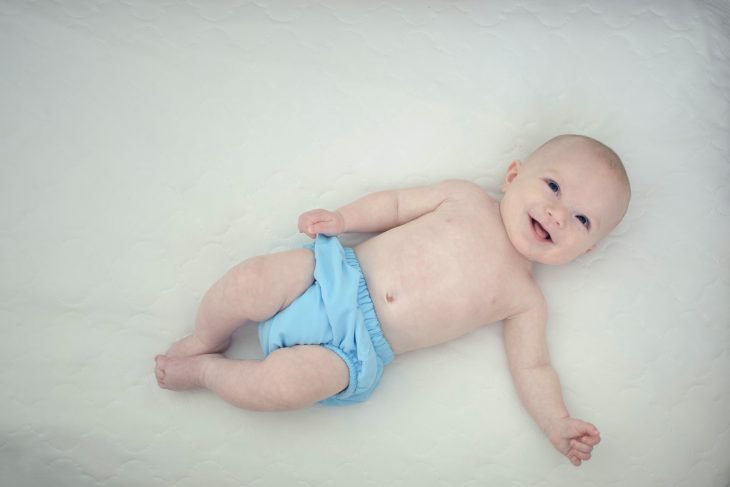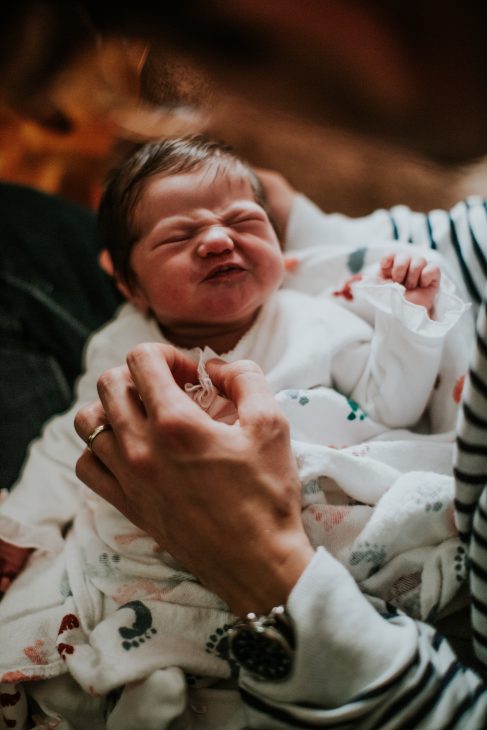The blue line on diapers may be confusing to some parents, but honestly, it is one of the best features a diaper can have! The vertical blue line on a diaper helps parents know when it’s time to change a diaper so that their baby’s delicate skin isn’t sitting in his or her own urine which can cause diaper rash, or an otherwise dirty diaper, for too long which can irritate the sensitive skin. Want to know more about the blue line on diaper? Join us as we explore exactly how this magical blue line works.
What Does the Blue Line on a Diaper Mean?
What Are the Lines on a Diaper For?
The blue line on a diaper is the brand of diaper’s “wetness indicator”. The line works by turning a specific color, bright blue, whenever the diaper comes in contact with moisture. Wetness indicators are an important feature of diapers because it alerts parents that a diaper is soiled long before the parent may know that urination has occurred. Because of this, this feature helps babies stay drier for longer and helps avoid the skin rashes. It also decreases the chances of diaper rash, discomfort, and skin irritation.
Related Read: Best Diaper Bag
It is important to note that a diaper’s wetness indicator may, at times, not change color. This can be for a variety of reasons. If the urination happened but didn’t quite happen at the front of the diaper where the indicator lies, you may think your baby has a dry diaper when, indeed, he or she may not.
Other times when a diaper’s wetness indicator may not work is on particularly hot days after urine or moisture has evaporated, or when your baby has pooped without urination–more on that later!
What Makes the Diaper Strip Turn Blue?
Any type of moisture in a designated area in your baby’s diaper can cause the wetness indicator located on many diapers to turn blue. A blue line at the front crotch of your baby’s diaper is an indicator that your baby has either urinated in his or her diaper or has come into contact with something wet.
In either case, it is a good idea to change your baby’s diaper to prevent chafing and rash as a cause of wetness of the diaper being against your baby’s skin for too long.
Note: Sometimes a baby’s diaper will be both blue and yellow! This happens because the wetness indicator is only picking up spots where the urine, or moisture, is more saturated. This usually means that your baby has only peed a little and may not yet be in need of a diaper change. Unless, of course, there is also stool present.
What is Wetness Indicator Made Of?
Depending on the brand of diaper you purchase, the wetness indicator can be made of varying compounds. In many cases, the wetness indicator is made of something called bromophenol blue which works by changing color in accordance to moisture that is either acidic or alkaline.
Pampers Wetness Indicator: Do Pampers Diapers Turn Blue For Poop?
Does Pampers Diaper Line Turn Blue For Poop?
Diaper lines do not normally turn blue for poop.
Still, you may notice that your baby’s diaper turns blue after your baby has pooped. If this happens, it is most likely that your baby has peed and also has pooped in his or her diaper. Either way, you will want to change your baby’s diaper right away.
To know if your baby has pooped, simply smell near his or her diaper. If you are unable to smell anything (sometimes this can happen even with poop) you may be able to simply check the back of your baby’s diaper to look for poop, rather than remove the entire diaper. This is especially helpful when you are out and about and don’t want to stop off at the bathroom to check your baby’s diaper for poop.
Remember that keeping a baby’s diaper on after he or she has pooped could have serious implications on his or her health and wellbeing. Never leave your child in a diaper that is heavily soiled or has poop in it. Your baby may end up with a bladder infection, a nasty rash, or chafing. Not to mention, it is extremely uncomfortable for your baby to sit in his or her own feces. We’re sure you can imagine!

Does Blue Line Mean Wet Nappy?
Yes… usually.
The blue line on a diaper is meant to tell you that your baby’s diaper, or nappy, is wet. However, this isn’t the only time that your baby’s nappy could change color. If your baby’s diaper comes in contact with water or other liquid substance and it reaches the inside of the diaper, you may notice the blue line on the diaper begin to change.
This can happen often in the summer as you may find your baby to be exposed to water more often whether he or she is at the pool, beach, or lake. It doesn’t necessarily mean that your baby has peed, but it might. Either way, you will want to change your baby’s diaper. Leaving him or her in a wet nappy, whether urine or water, can lead to chafing, discomfort, or a rash.
How Do You Know If a Diaper Is Dirty?
To tell if a diaper is dirty, you’ll want to watch for the following cues:
- Wetness Indicator: As mentioned, the wetness indicator on a diaper signifies that your baby has likely peed and is in need of a changed diaper. The fullness and thickness of the line will usually let you know just how soiled the diaper is. Remember that the blue line indicator can at times be both yellow and blue. This just means your baby has wet themselves a little, but may not be in need of a fresh diaper. Unless of course, he or she also defecated in the diaper.
- Smell: As we’re sure you know, simply smelling your baby’s diaper can let you know if it’s dirty or not. But this isn’t always a very reliable method when it comes to determining if your baby has peed.
- Weight: If your baby’s diaper feels heavy, then your baby’s diaper is likely long overdue for a change.
- Swollen Look: In addition, a swollen diaper is also an indication that your baby’s diaper needs to be changed right away. A swollen diaper indicates that the diaper is holding a great deal of urine or excrement. This should be removed from your baby as soon as possible.
- Fussy Baby: A baby won’t like sitting in his or her own excrement because… who would? Be sure to check your baby’s diaper if he or she is fussier than usual.
- Time Elapsed: If it has been an hour or two since you last checked your baby’s diaper. It may be time for a change. Try your best to pay attention to your baby’s schedule in terms of when he or she usually pees and poops. Also, try to stay consistent with checking on and changing your baby’s diaper to keep them as comfortable as possible.

Decoding Diaper Brands
Pampers Blue Line Front or Back
When putting your baby’s diaper on, you’ll want to put the diaper on so that the yellow line is facing the front and not the back. Once the line turns blue, you know that it is time to change your baby’s diaper.
Blue Line on Huggies Diapers
The blue line on Huggies diapers means the same thing that it does on Pampers and other brand diapers. It indicates that your baby is wet and will need a diaper change, especially if the entire yellow line on the diaper has turned blue.
Pampers Yellow Line Turns Blue
If your baby’s Pamper diaper yellow line turns blue, be sure to change his or her diaper. This is an indication that the diaper is wet.
The only time you do not need to follow this protocol is if the yellow line is only spotted blue here and there. This often means there is only a little bit of urination in the diaper.
Nevertheless, you should do what is most comfortable for you.
Blue Line on Diaper: Time For a Diaper Change!
A blue line on a diaper typically signifies that it is time for you to change your baby’s diaper. Though this typically is only the case for urine and not feces.
If your baby’s diaper line has turned blue, you should change the diaper in order to keep your baby dry and comfortable.
Next posts on the blog:
- My Ubbi Diaper Pail Smells Awful, How Do I Clean and De-Stink It
- Best Diaper Pail for Odor Control Reviews
- Why Is My Baby Going Back to Diapers After Potty Training
Lynn
Lynn is a freelance writer, a wife, and a mother of two beautiful kids. Lynn started Infant Empire with the aim of making parenting easier for fellow mums and dads. She believes the parenting tips provided here will be of great help to all parents.Recommended Reading
Top 5 Best Cloth Diapers for Heavy Wetters (2023)
The best cloth diapers for heavy wetters need to have the right absorbency for night time but finding them tends to be a major challenge..
Best Detergent For Cloth Diapers In Hard Water (2022 Reviews)
Hard water leaves mineral deposits cloth diapers causing build up that traps bacteria. Thus, you need the best detergent for cloth diapers in hard water.
My Ubbi diaper pail smells awful, how do I clean and de-stink it?
When your Ubbi diaper pail smells awful no matter how hard you clean it, you can use homemade products like baking soda, vinegar, essential oils.....
How to wash cloth diapers for the first time
This article provides a simple routine on how to wash cloth diapers for the first time. Cloth diapers wash routine is pretty simple and begins with........
What to put in a Diaper Caddy: Checklist for an Organized Changing Station
A diaper caddy or organizer keeps essential baby items organized in one place. But how do you decide what to put in a diaper caddy? Here are some ideas.
Huggies Slip On vs Pull Ups, Which To Buy? (2022)
Huggies slip on diapers vs pull ups, what is the difference? Slip ons make changing quick and easy while pull ups are great during potty training.

Leave a Reply